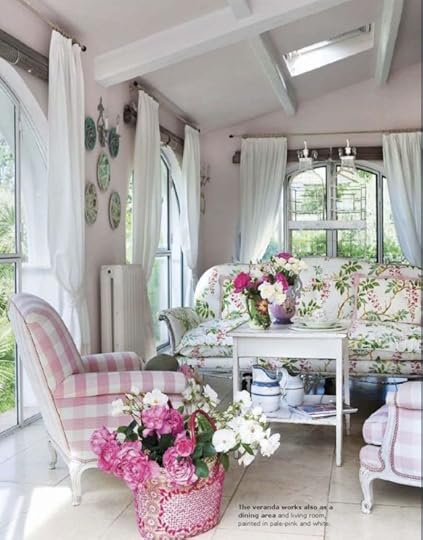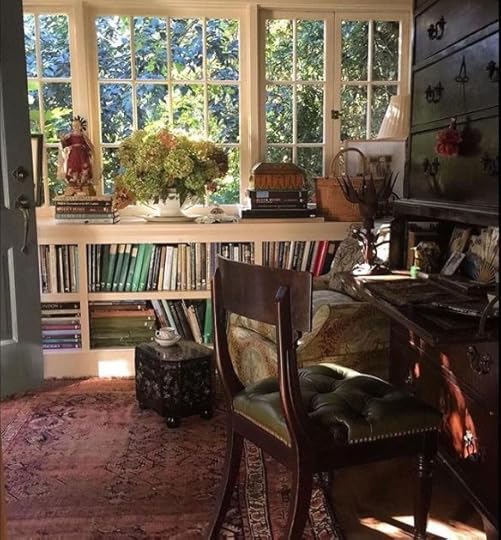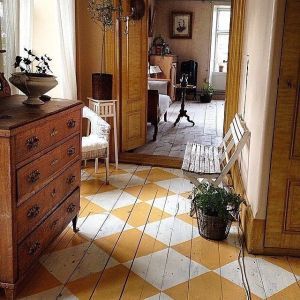Elizabeth A. Havey's Blog, page 11
January 17, 2021
COVID 19 VACCINES HAVE SAFE & SCIENTIFIC ROOTS
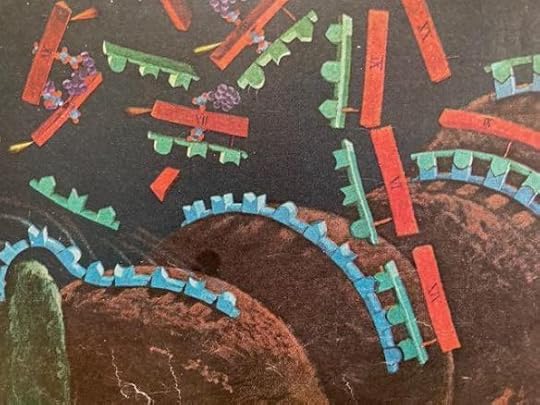
RNA at work…
She was a nun, Sister Natalia, and when she spoke, we sophomore girls decided that she needed adenoid surgery. But this aging woman was whip-smart, and I began to truly listen to her, discovering that I was enthralled with a subject I had never studied before—biology.She covered the basics, vertebrates and invertebrates. We looked in microscopes to identify unicellular ciliates like paramecia. We learned to define words like flagellum and cytoplasm.But concurrent with these basics Natalia was teaching us—was a series of magnificent articles in LIFE MAGAZINE. The series was called The Human Body—this was late in 1962.IF YOU KNOW WATSON and CRICK, YOU KNOW SCIENCE
The articles, what Natalia was teaching us, was the beginning of my falling in love with science, and much later becoming an RN. The LIFE MAGAZINE series was ground-breaking and I saved some of the pages, still have them. Part three was entitled: HOW FUEL BECOMES ENERGY.
The above photo is a science illustrator’s conception of Messenger RNA or mRNA—what scientists are using now to create the COVID vaccines that will save many lives.
The article described the drawing: Here the Messenger RNA is joined by fragments of another RNA molecule called Transfer RNA (green). These have different types of amino acids trailing from them (red prisms with different numerals). The amino acids attach themselves to the Transfer RNA with the help of ATP and enzymes (red and yellow spokes at the upper center). Then the transfer RNA interlocks with Messenger RNA, causing the trailing amino acids to join in a long chain. Such a chain is a protein. Ready for use, the protein leaves the ribosome (far right). Thus, the precise, predetermined pattern has been passed on from DNA to Messenger RNA and Transfer RNA to make a protein chain—which is what the cell set out to manufacture in the first place.
I FORGIVE YOU, if you didn’t read all of that. I just want to emphasize that this SCIENCE has been around for many years. The creators of the vaccines to fight COVID19 are pulling from established scientific norms which were know and utilized before some of you reading this were even born. Terms above and others like mitochondrion, coenzyme are not new to our world!
SCIENCE AND PERSONAL HEALTH
When my husband was diagnosed with CLL (Chronic Lymphocytic Leukemia) in 2002, his knowledge base was that of a healthcare consultant, so he was familiar with more medical terms than most. I was a registered nurse—but I had to look this disease up in my Medical Surgery textbook. The first thing I found was that “these patients live for about five years.” I then turned to the copyright date—this was an older book. I immediately had hope—medical science is constantly finding ways to cure disease, improve overall health. Today, my husband is as feisty and healthy as ever. THIS IS ONLY TO EMPHASIZE, we need to believe in science.
FIGHTING COVID 19
Married couple and doctors Ugur Sahin and Ozlem Tureci run the BioNTech lab in Mainz, Germany. When the United States and other western countries began to pay more attention to the virus that was spreading in China and killing people, they both realized it could spread around the world, causing a pandemic. Sahin immediately began work to discover a vaccine, using mRNA or messenger RNA.
A recent article in TIME MAGAZINE, took us back to the time period I refer to above. “Scientists …at Cambridge and James Watson at Harvard first identified and isolated mRNA molecules in 1961…Then in 2005, a pair of researchers at the University of Pennsylvania, Katalin Kariko and Drew Weissman, showed how to tweak a synthetic mRNA molecule, so it could get into human cells without being attacked by the body’s immune system. This and other discoveries are the reason that in the autumn of 2012, my husband entered a clinical trial that used monoclonal antibodies to attack his cancer cells and thus add years to his life.
DEFINITIONS: An antibody is a Y-shaped protein produced by B cells, which are part of the immune system. There are several different kinds of antibodies, and typically vaccines are designed to produce the antibodies that recognize and “tag” viruses as foreign invaders by binding to unique parts of a virus.
Antibodies that bind to the surface of a virus and block entry into a person’s cells can actually prevent infection or disease: this is called neutralization. These antibodies, which occur naturally in some people after vaccination or infection, can be copied in the lab and then given to people as a prevention option or treatment. The term “monoclonal” refers to these laboratory-made antibodies.
FINAL THOUGHTS: ARE YOU NERVOUS ABOUT GETTING THE COVID 19 VACCINE?
All of this is to emphasize that science is keeping us alive, is fighting COVID 19. The terms one reads about in relation to the vaccines have been around for a long time. The very up-to-date article in TIME concludes: The ability to code messenger RNA to do our bidding will transform medicine. As with the COVID vaccines, we can instruct mRNA to cause our cells to make antigens—molecules that stimulate our immune system—that could protect us against many viruses, bacteria, or other pathogens that cause infectious disease. For a visual chart to to: https://www.coronaviruspreventionnetwork.org/coronavirus-vaccine-and-antibody-science/
PHOTO: LIFE MAGAZINE, from pages I’ve kept for a lot of years!
January 10, 2021
What to Wear to the Revolution….
Elizabeth from Knoxville Tennessee chose a piano scarf to highlight her frightened, tear-streaked face when she was stopped outside the United States Capitol this last Wednesday, January 6th. “Yeah!” she told a reporter who stopped her as she ran from the scene: “I made it like a foot inside and they pushed me out, and they maced me.”
In the falling temperatures of that moment, the sky over the United States of America darkening, clouds and crowds gathering for the tempest, Elizabeth from Knoxville was trying to figure out why she was there at all. It had not gone her way. What next? But she cried out: “We’re storming the Capitol! It’s a revolution.”
But the interested reporter was soon swept away by the crowds of people, eagerly running from the Capitol. And so is Elizabeth from Knoxville, though she might be trying to find the food court at the revolution. (Not my whimsy, but that of another writer). Anyone who watched this quick clip that was widely broadcast must see it as the metaphor for craziness that currently grips our country.
MORE IRONY
I had planned to post about “differentiation– a theory of family therapist, Murray Bowen, who created the term, describing the process of finding a balance between autonomy (being a separate YOU) and connection (being with OTHERS) while creating goals and working toward them. Or to make it simpler: the concept that within a family each child can achieve emotional maturity by becoming his or her own person, able to form healthy relationships.
But Elizabeth from Knoxville had not considered differentiation, or may I point out USING HER OWN BRAIN. She had drunk the Kool Aid, she had traveled to be part of the group, the mass, the revolution. She believed that within the mob, there was glory. This was better than fulfilling a homework assignment. This was better than a vacation. THIS WAS the 6th of JANUARY, when all crazy people would triumph for trump.
Oh, and Elizabeth in her piano scarf did have a goal, the goal of the group–destruction. But sadly, she was running AWAY from the scene, without a statue or a portrait, or the head of one of the congress members.
And yes, maybe as she fled, she might have been singing one of the platitudes about a NEW GOVERNMENT, the GLORIOUS government of trump. MAKE IT PERMANENT. Because for Elizabeth of Knoxville, who probably never read her Social Studies book, or cheated on the exam, she had been reborn into a new way of thinking:
“it’s easy, guys. You get in a car or on a plane and go to DC and a whole new life will be laid out before you. It’s a REVOLUTION!! Let’s make trump king.”
AND FORGET HISTORY
So they wanted to create a different government, a trump government. But MY GOD, this country did start with a revolution, and then for hundreds of years used judgment, research, the arguing of ideas to keep the heat off. (And yes there was the Civil War) But do we need this???
Elizabeth, back in Knoxville, decided, along with many other crazies, that a romp at the CAPITOL was all that was needed to change things. Maybe the phrase Civil War only related to some dusty books or an old film like GONE WITH THE WIND. Today is today and we are going to make a permanent change with our mob mentality. We are going for it. How ironic. Oh, and when I first saw this clip, I tweeted that possibly she got really really angry when given a certain homework assignment. After all, that’s limiting her freedom. Time to grab that piano scarf and start a revolution.
FINAL THOUGHTS
So forgive my going off script today. But if you are full of doubt, if you have a family member who doesn’t want to listen to you or you don’t want to listen to them, maybe this questionnair created by differentiation guru Murray Bowen will help.
Which of Bowen’s statements, defining self-differenciation, applies to you or your children or grandchildren?
I understand the position I hold in my family, and the power given and not given to that position.
I am committed to be fully responsible for my own life, while committed to those I love.
In developing autonomy, I set goals for my dreams and ambitions, yet develop intimacy by allowing those close to me to see and know me as I really am.
I can tell people what I need, ask for help, but not impose my needs upon them.
I am able to detect when controlling emotions and reactive behavior have sent me in the wrong direction; then I opt, instead, to use creative thinking to make better and more purposeful choices.
THANKS FOR READING Thanks to Hunter Walker for the photo.
January 3, 2021
Decorating Inspiration: Shabby Chic
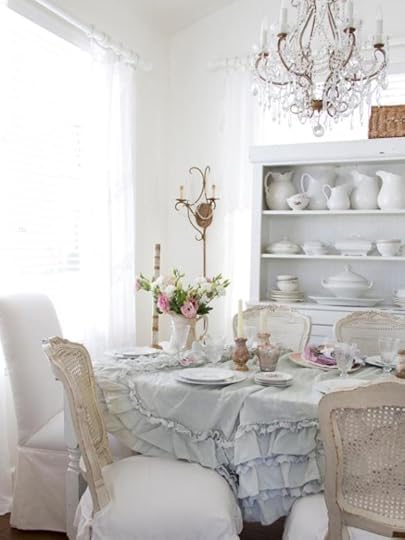
White pitchers, roses, crystal–this is Rachel’s signature style.
Treasure hunting? I’ll admit it, when it comes to big garage sales on a summer afternoon–it’s so much fun to come home with a treasure. My writing desk was in an “antique store” which is really another name for selling stuff people no longer want. It’s oak and serviceable, but I’m sure its value lies in my love of it.
And right this moment, I ask you to look around the room you are sitting in–because I am sure there is at least ONE ITEM that you picked up at a sale (garage or other venue), or you inherited or it was a gift from a dear friend–and it is something old and chipped, or white enamel, painted with roses, or covered in needlepoint and you will never part with it.
HOW RACHEL FOUND HER CALLING
Rachel Ashwell was born in England and remembers the excitement of walking through flea markets on cold mornings with her parents. They opened the door to what became not only Rachel’s passion but a rich and profitable business. She now lives in Malibu, California and has her cornerstone store in LA. But I have bought many of her designs through her Target Brand–and have followed her style by reading her Treasure Hunting and Decorating Guide. It opened my eyes as to FINDS at sales–garage, antique, flea markets, rummage sales, swag meets and tag sales.
WHAT TO LOOK FOR
Stopping your car when you see a piece of furniture at the curb is one thing. But spending hours examining pottery and glassware, finding the uses of items you have never seen before is another.
It became a passion and a hobby with me. In the suburbs of Chicago, I held and visited garage sales, garnering cast off chairs–you set the chair in your garden and place a plant on the seat and let ivy trail down. Tins, gardening tools, flower pots can fill an old baker’s rack that you have to spray paint every season or just let it become a chipped antique.
In Iowa, I found McCoy pottery at the Iowa State Fair, crystal candle sticks and white pitchers. I now have a collection. And I am always on the lookout for a single plate that I can display or hang above my kitchen cabinets. Anthropologie plates are expensive–but if you head to the back of the store there are always some on sale.
RACHEL knows the value of old sheets, pillowcases, napkins, hand towels–any of these items being even better if they are monogrammed with the name of a hotel or a bride’s initials. She also recommends anything that is embroidered or hand stitched. She refers us to a time when these items were precious and thus were mended if they tore.
I treasure a quilt that my grandmother made for me when I was married. It’s pattern is THE TREE OF LIFE and each of my children and grandchildren have been photographed on the quilt.
COLORS, PASTELS, WICKER AND WOOD
Rachel loves white, soft greens and pink in all of its shades, especially if you add a painting or a pitcher of cabbage roses, another aspect of her signature style. She places wicker white furniture against a backdrop of pink white or soft blue. In my last home, the guest room featured bedding styled by Rachel, prints of flowers and a built-in shelf where I displayed books from my childhood, paintings done by my grandchildren and framed photos of loved ones.
This new house is smaller and a bigger challenge as to how I can honor my Shabby Chic items. One wicker chair is already gone–via a neighborhood organization where you can post a photo of the item on Facebook, provide the street and general area where you live, and people can then write back if they are interested. This is a great way during Covid to look for castoffs that just might become precious to you.
In the famous yearly sale that my church in Des Moines held, I found the best of the best–things I still cherish. A big white chest that I painted, adding new hardware. A painted toile tray that I will never part with. High-end pillow cases and linens that I cherish. A small stool that has probably been repainted five times.
And crystal! Rachel will hang a crystal chandelier anywhere–and I love how crystal plays in light, especially sunlight. My mother-in-law said yes, when I asked for a bag of crystals that I found in her bedside table. They had come from a lamp and she loved how they played in the light. I have hung them, displayed them–and though we weren’t in love with a chandelier in our last dining room, it provided a great place to hang the crystal ornament we receive every Christmas from dear friends. THINK OUTSIDE THE BOX.
NEED A FUN PROJECT?
So to welcome in a year that is new, but also stymied in some ways by Covid: cruise your dwelling. What room could use some new paint? What piece of furniture would brighten a room if you chose some awesome color of milk paint and gave it a new life?
No matter where I live, I will always be eager for setting a mood, repurposing an item or finding a better use for something I own or a treasure I have come upon. I won’t say Rachel Ashwell changed my life, but she underlined the beauty of the “found” item and emphasized that cherishing and repurposing old things can bring warmth and charm to your life.
December 27, 2020
Decorating Inspiration: This Week, Mary Engelbreit
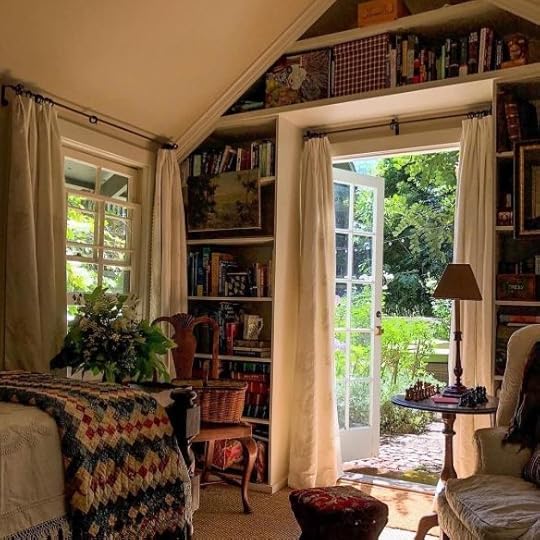
Decorating Inspiration: This Week, Mary Engelbreit
Every house I have ever lived in, inspires me to create a HOME. But wow–over time, have my tastes changed. I’m old enough to have lived in the avocado green & harvest gold period. This was our first house, a track house with spring green carpeting and touches of orange and gold everywhere. I even painted my antique wicker desk orange. (I still have that lovely desk and now it is properly white.)
Our second house went through many stages: from a yellow living room to a lovely federal blue. From orange shag carpeting in the family room to oatmeal Berber. During negotiations on our third home, I walked out the door, unable to picture how this house with great bones could actually become a home. But after conceding and after a total remodel, the house became everything I wanted. But life changed, my husband took a job in Des Moines, Iowa.
The Cape Cod in Des Moines will probably remain my favorite. But following the usual pattern, it needed a lot of work. That’s when I discovered Mary Engelbreit, her ability to transform each room so that it reveals your personality, highlights the things you love.
The smallest bedroom had not been touched in years. So—I painted the walls a soft light gold and sponged on deeper shades for texture. The trim was white. I hung Belgium lace valences on the windows and a quilt behind the bed to serve as a headboard. I sanded an old chest, only to bring it down to “pedimento”– revealing was was underneath–blue. New hardware highlighted that color. I hung a copy of a Picasso print from his blue period, and used white whicker baskets to hold pillows and shawls. A drawing of a picnic on laminated pressboard became a table when I set it on top of a luggage rack. I loved to tell anyone that admired the room: “Nothing in this room is new. I just dug in my closets.” I wish I had a photo of it to show you.
Many of my ideas were fueled by reading Engelbreit’s books and looking at endless photos of her transformations. It was great fun and the bones of the house were perfect for the style of that time. (Next week: Rachel Ashwell’s Shabby Chic)
Below, more Ideas from Mary Engelbreit: All photos are of rooms done by Engelbreit–they are not my rooms.
December 20, 2020
Will You Miss Someone This Christmas Season?
I have no memories of my father at Christmas. Any Christmas. He died in spring, he died when I was three, when memory is just beginning to be a part of the human brain.
We might think we remember our birth, seeing our mother’s face for the first time and then living our lives: diaper changes, crying for a bottle, being held. But the brain can’t separate out those particular memories. Living is a blur and comfort is the goal. If we feel pain, hunger, cold, discomfort, or if we are startled by loud noise or voices that changes the quiet we’ve been experiencing, then we cry. It’s how as infants we express ourselves: please keep me comfortable, okay, but none of this other stuff.
LIFE IS BASALLY A VERY LONG DAY AND NIGHT. WE HAVE NO CONCEPT OF TIME.
If you have early childhood memories, it’s probably because stories related to you by your parents helped form such memories. Hopefully your memories and thus your stories are pleasant and positive. What is truly interesting is why you have these memories at all.
OBJECT PERMANENCE, FORMING MEMORIES WITH A DEVELOPING BRAIN
Researchers, using the theory of object permanence, first stated that babies couldn’t form memories. When an object was covered—it was out of sight and out of mind.
But Nicholas Day recounts in an article for Slate some new findings by Patricia Bauer, professor of psychology at Emory University. She says very young children are able to form memories, like adults, but they have to do so utilizing a hippocampus and prefrontal cortex that is still developing. They capture only part of the present as it flows by–and such memories will not move with them into adulthood.
MEMORIES STICK FOR A SOCIAL REASON
So why do our memories form after the age of three? Bauer states: “Memories are made up of these little tiny bits of information that are coming in literally across the entire cortex. Parts of the brain are taking those little bits of information and knitting them together into something that’s going to endure and be a memory.”
Using metaphors, she states that adults have a fine-mesh net to catch the memories, but babies have a big-holed colander: the memories slip through while the baby’s developing brain is trying to organize and stabilize them. Children just under two are able to retain more—even though memories of their second birthday party won’t last into adulthood. Bauer sites that the immature brain is definitely one reason for that, but most interesting is that the lack of language to facilitate and represent those experiences.
So why do memories begin to stick around 3½ years of age? It’s a social reason rather than a neural one. Research now states that memory forming is clearly related to the free flowing “story” that a parent creates while raising a child. Even if a child can’t keep up a conversation, “highly elaborative” mothers and fathers help a child create memories by using parenting narratives. (Another reason why many children thrive early on when surrounded by caring parents who talk to them and invite them into the conversation.)
IT’S IN THE STORY
Psychologists studying the interchanges between parents and children note that parents often ask a child repetitive questions about a past event—or they recount the event in detail asking the child questions and incorporating the child’s answers into the telling of the event—or story.
Day writes: When children remember and talk about the past, they effectively relive the event—they fire the same neurons and reinforce the same connections…The word story is important here. Children are learning how to organize memories in a narrative…” And Robyn Fivush, another psychology professor at Emory, states that more organized memories are better retained.
One person commenting on Nicholas Day’s article states he can remember being in the womb. I truly find that hard to believe, yet maybe his mother created a story about that experience or asked him questions and that helped create a memory.
A POET’S THOUGHTS ON MEMORY
Poet David Whyte says that we can live the past, present and future all at once. He says we have no choice in the matter! If you’ve got a wonderful memory of your childhood, it should live within you. If you’ve got a challenging relationship with a parent, that should be there as part of your identity now, both in your strengths and weaknesses. The way we anticipate the future forms our identity now…We are never one thing; we are a conversation—everything we have been, everything we are now and every possibility we could be in the future.
FINAL THOUGHTS
Though this holiday season might not be ideal, because you are separated from people that you love because of distance and/or Covid19. Our modern lives allow us to communicate with one another and YES, create memories. Though using the internet is not ideal, you can’t hug your grandchildren and children–you can talk to them, profess your love for them. You can toast your friends and grown children. So…
Talk to your young grandchildren; help them form positive narratives about their lives and thus positive memories. Share your own amazing memories with your children and grandchildren. Note that your relationship with your children and grandchildren becomes part of their story and memory. Fill it with love and understanding, not complaints and anger. After all, day to day you are creating a family story. Make it a good one. And wishing you health and peace.
December 13, 2020
Living in the Body Part 2
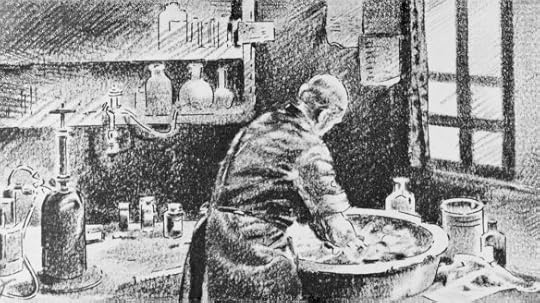
Ignaz Semmelweis washing his hands in chlorinated lime water before operating.
Language can and often has been a barrier to taking charge of one’s health. The internet and the ability to harvest information has greatly helped. But in previous times, when there was no easy access to information, this was certainly not the case.
THE ABUSE INSIDE INSTITUTIONS
Consider changes in a person’s mental health or the adult with language difficulty or language barriers. For many years and in many countries, if you didn’t meet certain standards in your actions and verbal ability, you were often labeled insane and housed in an institution where you were considered less than human. Though within you were the basic needs to be loved and cared for, you were mistreated, abused, even raped. Many stories surrounding mental hospitals have been unearthed, books written, films made. Many reveal true horror stories.
THE CLASSIFICATION THAT LABELED CHILDREN and ADULTS
Below is a copy of the classification system that labeled a person’s mental ability using cruel terms–actually used by doctors, nurses and other health officials.
Idiots. —Those so defective that the mental development never exceeds that or a normal child of about two years.
Imbeciles. —Those whose development is higher than that of an idiot, but whose intelligence does not exceed that of a normal child of about seven years.
Morons. —Those whose mental development is above that of an imbecile, but does not exceed that of a normal child of about twelve years.
— Edmund Burke Huey, Backward and Feeble-Minded Children, 1912
ADVANCES IN MENTAL HEALTH
But through research, eventual open-mindedness and time, medical professionals and society at large, came to understand that poor nutrition and housing, exposure to sick environments, the lack of love and good parenting contributed to mental ability. Research and steady, thorough evaluation of clients led to the defining of conditions like bi-polar disorder, schizophrenia or borderline personality disorder. We now know that people with these conditions often function differently than the norm, but still can love and live good lives that benefit from the medications created to help them do so. Our humanity demands this. All people deserve love, respect and human contact.
ADVANCES IN PHYSICAL CARE
But for centuries, physical disabilities usually meant you did not receive everything you needed. Your full personhood was disregarded and you were often labeled: gimp, cripple, and yes, moron. But damn, you were not less of a person. Yet it took years, even in the supposedly forward thinking USA, for people with disabilities to be understood and to be heard. Now finally we have been enlightened. We understand that a person who is physically challenged is, of course, a full person–that he or she can work and travel and take care of a family–with the help of changes that accommodate them, encourage them to prosper and provide for their special needs.
MORE LABELS
But in those older, uneducated days, labels were heartless and they were everywhere. Consider how medical people and medical institutions in England labeled their centers of care: Crippled Children’s Hospital; Chronically Ill Hospital; Insane Asylum. Your diagnosis as you were wheeled in was printed in stone on the front of the building. You were sentenced. The very names shouted out that the hospital lacked knowledge, lacked understanding. They failed to understand that these patients were human, and that being human demands our physical bodies, our minds and even our goals and loves should be treated with respect–within that setting.
And though some complain about it, today’s hospital stays are shortened to allow the person to go back to family and society, to live as normal a life as possible despite the condition he or she has.
(My eye surgery that I have written about, was done when I was five. It required that I stay in the hospital for a week! Away from my mother. The surgery also required that BOTH of my eyes were covered with gauze during that time. Someone fed me, put me on the bedpan. My mother could visit for one hour per day and there was a day when she was unable to come. Bad memories for me.)
Today, that procedure and most others are done in an outpatient setting, requiring maybe four to five hours of recovery, and possibly periodic visits to a medical office post surgery. We have come a long way, working to get patients discharged to home and back into society, helping them live as normal a life as possible with whatever illness or condition they have.
A PERSON IS NOT A DISEASE
And this is so important: a person is absolutely not the gallbladder in 305 or the rheumatoid arthritis in 312. We are all people, humans who sometimes become ill and ask our medical community to help us, to encourage us so that we can work our way back to full health–or to the best that we can be.
But how many of us realize that our human body is a gift and that we only get one? When do we really start living in the body that we have been given?
Currently, with Covid19, many of us are more aware than ever. We wash our hands, drink fluids and we swallow a lot to see if we have a sore throat! At least I do. But again, there are folks who don’t stop smoking until they are in their 90’s with Congestive Heart Failure. Or there is the teen with genital warts (HPV) who is told she now has Pelvic Inflammatory disease (PID), but she is certain the nurse is lying to her. And so she denies it for months, infecting others–the point being, that until she accepts the diagnosis and begins to live each day making it a part or her and seeking treatment, she will not be truly LIVING in her body.
HOW HUMANS, ESPECIALLY WOMEN, SUFFERED AND DIED
We benefit from modern science as to our mental and physical health. But the connection of mind and body was not always recognized. In the Judeo-Christian history, there was a strong pull to the heavens, away from the earth where living was hard. Cathedrals were built, but the human body was basically ignored.
Medicine was savagely ignorant. The care of the body suffered in these dark ages. Consider the Black Death. Or a farming accident where the cure was to cut off a limb. Many lived their later years with no teeth, and easily became blinded because of injuries. Sores became septic and you died. Women in difficult childbirth could bleed to death or become septic, because the presence of bacteria was not known, doctors with dirty hands being all over intimate parts of the female body when assisting in childbirth–until Ignaz Semmelweis.
Often described as the “saviour of mothers”, Semmelweis discovered that the incidence of puerperal fever (also known as “childbed fever”) could be drastically cut by the use of hand disinfection in obstetrical clinics. Puerperal fever was common in mid-19th-century hospitals and often fatal. Semmelweis introduced the concept of washing of one’s hands in chlorinated lime water before operating. HARD TO BELIEVE, RIGHT? But bacteria were invisible. The world worked by what was evident.
FINAL THOUGHTS
But truly, the body was thought to be secondary. Many suffered, hoping that their pain would be a path to the afterlife.
Today, people in medicine are constantly researching. Their goal is to improve life, cure disease, enable people who are handicapped from birth or from accidents to function as normally as possible. It has always been about living in the body, caring for that body. But today–in so many ways–that task is enlightened and aided by research and knowledge. Thus we strive to care for our bodies, to maintain them–and our minds–to appreciate the life we have been given. FINAL THOUGHT; WEAR A MASK!
Suggested Reading:
Unclean Hands; Andrew Schafer MD;
The Immortal Life of Henrietta Lacks; Rebecca Skloot;
Being Mortal; Atul Gawande
December 6, 2020
LIVING IN THE BODY Part One
Artistic Anatomy
If you raise a totally healthy boy and a girl, help them through their fevers and colds, provide them with healthcare if they get strep throat or a severe flu, I believe they will not relate to their bodies in the same way when they are seventeen.
The female will be more in tune with hers than the male. Why, you may ask. Well, early on she learns about menstruation. Well yes, you respond, but males have things happening to them too! Yes, that’s true. But the girl is better prepared to live in her body. Why, you ask again. Because she becomes familiar with blood.
WE LEARN TO LIVE IN THE WORLD
From our first breath, we live inside our bodies. As babies we lie in wonder of air and light, the beginnings of sight and sound, as we gradually determine that our mothers are not part of us–but that our hand is. And that we have these two appendages we learn are our legs with other appendages we learn are our feet. My daughter Christine was toeing in at six months and had to wear special shoes to prevent a future problem. Did she fuss? No. At that time, it was all part of the progression of living.
As babies, we learn that sucking with the mouth nourishes us, that crying brings comfort and warm touches.
We have no language to define any of this, but we have instinct and that drives our need for food, comfort, warmth and dryness. If these needs are not met, we know how to kick and scream. After all, we came into this world kicking and screaming, and if fortunate, we were immediately given warmth, comfort and eventually food.
BECOMING MORE INDEPENDENT
The developing infant is not aware of the need to urinate and defecate. It is only through growth, the awareness of being wet and uncomfortable, that increases awareness of the body and helps our parents teach us good toilet habits.
Hunger and thirst determine how we experience the hours of the day. We cry for the breast or the bottle. We wake up when we are hungry, and as we grow, we might even climb on a rickety stool to get to the cookie jar.
Hunger is that first human drive that establishes some sense of time in our lives, but then begins the long process of establishing balance and moderation. Even children can over-eat, leading to weight-gain, poor coordination and poor self-image. (But note, the inability to eat wisely can be a problem throughout life, one that hinders health and can lead to health problems and even early death.)
ADAPTATION
Another capability of humans is adaptation. If we lose a leg or an arm, over time we learn to adapt to that loss. We might have a prosthetic device to aid us, but the very fact of losing part of one’s anatomy demands a great deal of physical and psychic energy to grasp at life, to go on. But surely, humans are survivors.
A deaf child compensates by placing hands on the throat of a speaking person to feel the vibrations. Blind children use their hands to explore the world and turn their heads to pick up the sounds that alert them to the world around them. But compensation is not a good idea in an adult who truly is having difficulty seeing or hearing but refuses to wear glasses or hearing aids.
A chronically ill child will not accept a parent saying that he or she is “just fine.” Deep within the psyche, the child will put things together, and often better accept this change in his or her life than the parents. Honesty is the best way to go.
AGING AND ACCEPTANCE
What I do question, and would love your thoughts concerning this—is that as we age, why does our ability to accept death and dying become even harder for us? It is the long span of health, independence, and our functioning that disallows us to acknowledge that we are mortal and that we will die? As Wordsworth wrote in his poem, Intimation of Immortality, maybe children do arrive in this world:
But trailing clouds of glory do we come From God, who is our home: Heaven lies about us in our infancy!
Or is it because children do not have as firm a stake in the world as adults have. Throughout life, all of us must compensate and adapt. Sometimes it is only for a short while.
I wore bandages on both eyes for a week after eye surgery. I was only five. A friend developed MS, Multiple Sclerosis. Her ability to compensate and adapt now colors her entire life. If we lose an arm, we are still the same person. That hasn’t changed us.
Nor have the scars of a traffic accident or a fire–we are integrally the same person, now needing to sorrow over our loss, go through the struggle to adjustment, form that altered person we now present to the world, though inside we have not truly changed. And it is horrible and wrong when someone might label us, the speaker doing so to distance himself from what could also happen to him–a human and deep-seated fear.
DEALING WITH PHYSICAL DIFFERENCES
Maybe we instinctively know that our bodies are fragile. From the beginning, we crave distance from the pain and suffering of others. But as a child, I did not realize I could give pain to someone else when I wanted to look away from their suffering.
Maybe I found my way into nursing to better understand that reaction, to acknowledge, to be more open. I believe that each of us, no matter the shape of our body, the losses or problems we might live with, deserves the acknowledgement of a whole human being. Thus I have learned not to run and open doors for the handicapped, unless explicitly asked to do so. Once I approached a blind man, telling him that the usual entrance to the mall was blocked by decorations. He whirled on me, told me he knew exactly where he was going. I had invaded his space. In that particular situation, I was wrong.
Do we take for granted our bodies and how to care for them?
Thanks to Artistic Anatomy for the lovely art.
November 29, 2020
Feeling Down? Move Your Body!
Yes, we have had a lot to worry about lately. And as you read this, I hope you are well. Statistically, someone reading this either has had COVID or has a friend or relative that does. Numbers are hard to ignore. So I am wearing my mask faithfully, knowing that prevention is the only way to prevent others from contacting the virus. We will prevail.
BUT HOW TO?
Well today it was 45 degrees, sunny, warm enough for my husband and I to take a long walk in our neighborhood. We used to live in Westlake Village, California, where our walks took us toward views of the low hills of the Santa Monica mountains. If we were really feeling adventurous, we would drive to locations where the hills were higher, the views even more spectacular and our bodies covered in sweat on our return.
Walking, hiking is so good for us. It’s a treat for our souls and for our bodies, and in some ways even more so for females.
BONE HEALTH
Bone health is important for both men and women. But as we age we often take it for granted. Our bodies are subtly or not so subtly changing and the statistics for bone breaks increase. Friends break a wrist, an ankle, a leg. Everyone wants to avoid this; no one wants appointments to the local orthopedist or physical therapist to fill your calendar.
Preserving bone, preventing falls and their subsequent breaks is crucial to overall health. Strong dense bones insure good posture, physical strength for work and activities, and good balance. A strong skeletal frame directly impacts physical appearance. People with healthy bones feel and look youthful. Bone health also increases psychological health. You can do more, embrace life without loss of balance, a bad fall and a debilitating bone break.
KEYS TO KEEPING BONE STRONG:
a diet rich in calcium; calcium supplements; and Vitamin D from sun exposure for calcium absorption;
avoiding the negative impact of smoking and alcohol; seeking out a good physician who can evaluate you for osteoporosis and how to stop or prevent its growth;
Osteoporosis is a disease of the bone that affects almost half of men or women over the age of 75, though women are five times more likely to develop the disease. Women have thinner and smaller bones to begin with and after menopause, usually around age 50, they lose bone mass as their bodies no longer produce estrogen, a bone-protecting hormone.
Bone is living tissue that throughout life goes through the process of constant formation (new bone is formed) and resorption (old bone is broken down). Aging changes the process in both men and women. More bone is lost then new is formed. The skeleton slowly declines. Osteoporosis literally means “porous bones;” the word describes bones that have lost an excessive amount of protein and mineral content—especially calcium. Bone mass and bone strength have decreased. Your bones become vulnerable to breaks.
WHERE WE WERE AND WHERE WE ARE NOW…
Previously it was assumed that this bone aging process could not be stopped. Our grandparents, and possibly our mothers and grandmothers, suffered height loss because of compression fractures in their vertebrae. These fractures often led to the formation of an abnormal kyphosis or dowager hump on the upper back. Debilitating hip and leg breaks often meant the duration of life was spent in a wheel chair.
Now post-menapausal women have options to keep bone strong and avoid the bone loss of previous generations. Calcium in the diet and weight-bearing exercise can help ward off osteoporosis. Bone density scans are used to check for osteopenia—the early stage of osteoporosis. Healthcare providers recommend the right amount of calcium supplements and stress diets rich in calcium and other minerals. For people who are at great risk for the disease or have rapidly advancing bone loss, providers often prescribe bisphosphonate medications like BonivaR and FosamaxR that can slow or stop the progression of osteoporosis.
THE GUYS TOO…
Men also need to be aware that by the age of 65 or 70 they are losing bone at the same rate as women. Though osteoporosis is often considered a woman’s problem, there are 2 million men in the United States with this disease. (an older statistic that could have increased)
The key is to keep bone strong by stimulating new bone growth. Any activity that puts increased stress on your bones, making your bones and muscles work against gravity (weight-bearing exercise) will help you build healthy bone. So are you doing any of these:
Walking, race walking, weight-vest walking, jogging, running
Aerobics, step aerobics
Cycling, if you can increase the resistance as some gym machines allow
Climbing stairs
Dancing, especially contra dancing, tap-dancing, polka and other folk dances that involve stomping and hopping
Soccer, basketball, tennis, volleyball, softball, pickle ball
Gymnastics, Weightlifting, Jumping rope, Martial arts, Bowling, Yoga, Pilates
Housework and yardwork: cleaning, gardening, shoveling snow!
THE BENEFITS OF YOGA
Paula Secker, an instructor of Anusara-Inspired Yoga, explains that the weight of your own body is utilized to create this weight-bearing exercise. Bones are strengthened as muscles of the body pull, hug, and shorten bone to achieve yoga poses keeping bone strong. Secker mentions popular yoga poses like downward facing dog and plank for hip, arm and leg bone strengthening. All standing yoga poses work the legs, and arm-balancing poses strengthen the upper body, which is often weak in women.
She emphasizes an additional benefit of yoga: it enlivens, opens and increases the energy of the body and body fluids like blood. Fluids enervate the entire body, working to increase the rate of bone cell production.
She also stresses that loss of balance is a great concern as people age—leg muscles weaken and other systems like vision, nerves and body receptors don’t supply the right signals to the brain. Once again Secker recommends yoga, as many poses require balance, and repetition and mastery is just what the brain needs to reestablish stability.
Yoga helps achieve body awareness and good posture. Poses require constant realigning of the body, particularly how the head sits on the shoulders. This fights forward head posture, a sign of aging, which is often exacerbated by computer work and weak musculature.
Do you sit at a computer often, like I do?
Secker stresses that there is a relationship between proper positioning of the head and the straightening of the torso and body core. Aligning the head to center position automatically tones the core and torso. Practice this when driving, imagining a cosmic head rest holding your head upright and keeping your body straight.
And make sure you add weight-bearing activity to your schedule every day. For starters—take the stairs!
So, thanks for reading….and I found this “creative stuff” –don’t know when or why I wrote it…
There’s a bar at one end of the room with cold reflecting counters and stacks of shiny glasses, donuts and sweet rolls, chocolate candies. I say to myself: “Everything but illicit sex.”
Also: But then I am walking around in my tight pants that are even tighter after the weekend. And if I were in a photo in some newspaper, the caption would read, “Woman about to go on a diet.” or woman should be exercising and going on a diet.
How is your body doing with Covid, and being indoors so much???
November 22, 2020
A Variety of Thoughts in the Time of Covid 19
I’m on Twitter. I like it there. If I am angry, I say so. People who are also angry, or simply agree with me, follow me. It’s virtual hand holding. Oh, I’ve had to block folks. They’d be the ones to tell me to shut up or worse. There were a few that threatened me. But I’ve decided to defend what I believe in, and I’m not silent concerning those things. Back in California, I walked out of a gathering, because the people there, in my opinion, had hardened their hearts.
Now there is Covid19–and ironically, it can bring people together. Last night a woman tweeted that her mother had died. I wrote back: So sorry. I have thanked God many times that my mother, the person who gave me more than I could every repay, died in 2013. TRUTH.
WORKING AT HOME
My mother Jinni was tireless. But now, she reminds me not to be tireless. To take care of myself and my family. To fight back at Covid. Jinni would. When I yearn for a nap, I think of her.
Jinni would sometimes walk into our living room and “collapse”, as she would say, on the dark green couch, falling instantly to sleep for five minutes or ten.
I often watched her as she struggled to get up and back to it. (My mother worked in our dining room, typing insurance policies to pay the bills.) At some point, I began to understand that she longed to have a reason to just relax, to lie there and do nothing. But for a widow with three children to raise, that reason never came. And at the end of the day, when she was “processing” what she had typed, pulling carbons apart and stamping paper and using paper clips, she would take my face in her carbon-smudged finger and tenderly kiss me.
How could I have become anything but active, when I had a mother who labored at home keeping us all perfectly safe and healthy, who settled us in school, and then one day put on high heels and nylons and went downtown to work.
Jinni might be comfortable with COVID. She’d be working at home again.
SHEDDING LIGHT ON THIS TIME
Now that many of us are home most of the time, we need to focus on things that lift the spirit: warmth, comfort, cleanliness—and also the stamp of our own individual personality. These are essential.
Our rooms call out to us and we decide to make some choices. A throw or pillow add color to a cloudy day. Books, plates and photographs provide comfort, help us decide that we are okay. We will be okay. And as we face the darker seasons, light is essential, enhances where we live. The blocks of sunlight on the floor; the rocking chair that creaks, because it was grandmother’s. The shadows, the lamplight, when daylight departs. If we have to BE HOME, let’s make it cozy, cheerful, comfortable.
TELEVISION
Many bloggers will alert you to things to watch on television. That’s awesome. And most nights that is what my husband and I do—currently watching THE CROWN. And also the news, Rachel Maddow. I cannot begin to say how her finally being back, telling us upfront, how she dealt with her partner Susan having Covid, and almost dying—how hard that was for Rachel to tell us, how that was for us to watch. The pain in her voice, her face. Especially since Rachel has been a constant presence, warning us, urging us to be careful. She is part of why so many people are still alive, so many doctors and nurses finally got the PPE that they needed.
READING
And there is always reading. On Sunday we get both the New York Times and the Chicago Tribune. We could read all day! And when we moved, almost all of our books came with us. Books are life.
From Lauren Grodstein’s A FRIEND OF THE FAMILY
“We were standing looking out on a beautiful April evening. The magnolia in the yard was cloaked in blossoms, and the rabbits that lived under the purple hydrangeas were foraging in the fading daylight. The air in the room smelled heavy with food and sweat and burning wax and Lysol and clean linen. Steve didn’t cry, didn’t speak, just held both my hands in his own. His grief was stark and monstrous behind his thick, gentle glasses. The room was silent.”
AND FINALLY: THIS IS FOR ANYONE WHO HAS EVER BEEN A LABOR AND DELIVERY RN
From Gentle Reminder by Ray Spooner
Go placidly amid the laboring patients and remember what peace there may be in coffee breaks. As far as possible without surrender, be on good terms with the unit secretary; for she controls everything…Enjoy each delivery as if it were your first…You are a labor and delivery nurse, no less than the obstetricians and the midwives; you have a right to be here. And whether or not it is clear to you, no doubt the universe will fall apart as soon as you sign out. Therefore, be at peace with God…and whatever your labors and aspirations, in the noisy confusion of shift change, keep peace with your soul. With all its sham, drudgery, and popcorn trodden into the carpet, this is still a beautiful unit. Be careful. Strive to be happy, and don’t go home with the narc keys in your pocket.
November 15, 2020
TRANSITIONS…
TRANSITIONS…
We all go through them. Some are major, some are slight. Every day that we awaken to our own breathing is a transition to a new day. Sometimes we want to shut our eyes and leave the world behind.
Think of a day when you awakened, knowing that this was the day you would bury your mother or father; or maybe your boyfriend or husband, girlfriend, wife–even your child. How did you get through that day? How did you put two feet on the floor and move into the burdens, the sorrows of that day?
Transitions can also be filled with joy–a new home, new job, vacation, graduation–or you are awake because, yes, you’re having a contraction, your water broke, your child will be born today.
PSYCHOLOGISTS BREAK THIS DOWN INTO KINDS OF TRANSITIONS:
Elected–you chose a new job; surprise–you lost your job; life on hold–you have cancer; sleeper–your husband is having an affair; and double whammies–your lost your job and your husband is having an affair.
AN ORDINARY DAY IS DESTROYED
But truly, when you think about an ordinary day in your life, it can be filled with transitions that you are forced to make: as simple as canceling a plan, to losing your best friend in a car accident.
We humans MUST BE STRONG, accept the possibility of transition and change. A phone call that your best friend was killed in a car accident will require you to use any strengths you might have to get through this. Will you rise to the occasion? Call the closet relative and offer your love, your help? Will you drive, get a plane or if it’s now and things are restricted, can you find the words to comfort all who have lost this person? STRENGTH, in such a situation WE NEED STRENGTH. And wisdom and faith.
BOTTOM LINES
When a person decides to put themselves in a position where the result of something could be positive or negative, they need to be adult, be able to release some control, and realize from the beginning that things could go either way. Psychologists even list the characteristics of managing transitions in life:
Your ability to plan; Timing; Having agency during the transition; Previous experience; and realizing that transition is part of life.
DONALD TRUMP LOST THIS ELECTION TO JOE BIDEN. Psychologists tell us that right now he is feeling disoriented, and disengaged. Oh you bet! So here are a few tips for Donald that might help him get through this:
Recognize why you are uncomfortable; Explore the aspects of the change; Talk to someone, get your feelings out; Use this transition as the impetus to a new kind of learning.
MY POINT OF VIEW
What I really want to say in this post, is that given the opportunity to show strength, provide good example to American citizens, it’s all about stamping his feet, calling out the referee and insisting that the game was called unfairly. I abhor such behavior. I would not want to see that in a seven-year-old much less POTUS.
People are dying every day; families are struggling with death, loss of income, their children not in school, mothers trying to balance work and childcare. GET A GRIP, DONALD, act like a man for once. You lost. Now help your country, that you said you loved, transition. You were elected to do a job that has boundaries and rules. OBEY THEM, for the sake of God and Country.
And remember: HOW A MAN WINS, SAYS A LOT ABOUT HIS CHARACTER. HOW HE LOSES, SAYS EVEN MORE.
THANKS TO CHARLES SCHULZ AND LUCY


